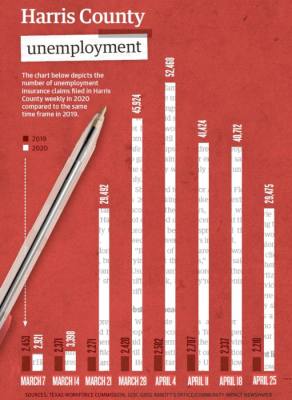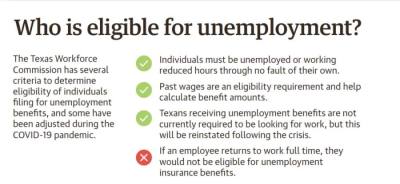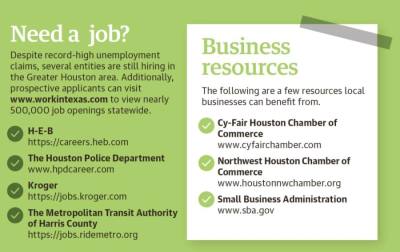When the coronavirus pandemic hit in mid-March and restrictions were placed on large gatherings, these shows were canceled for the foreseeable future.
The single mother of four said she and her family have only taken care of necessities such as food, gas and utilities during this time, and her savings intended for retirement and purchasing a home one day are dwindling.
Widger said she attempted to apply for unemployment as soon as possible, but the process took more than a week because the Texas Workforce Commission was bogged down with requests. The claim was denied shortly after going through.
“They gave a number that you could call in and discuss it with someone, and I called for weeks. Every single day I would call right on the dot at 7 in the morning, and I would call over 100 times,” Widger said. “It was nothing but either a busy signal or a recording that said ‘Due to the high call volume because of the COVID pandemic, we’re unable to take your call at this time.’”
More than 20,000 Cy-Fair residents filed initial claims for unemployment insurance benefits from March 18-April 18, according to the TWC. About 23% of these claims were ineligible for assistance.
Economy experts predict high levels of new claims each week will continue, but state officials are making efforts to get some Texans back to work.
Gov. Greg Abbott announced April 27 restaurants, retailers, movie theaters and malls could open May 1 with 25% occupancy restrictions. Should Texas continue to report a decreasing rate of new cases, Abbott is expected to allow these businesses to increase occupancy to 50% and expand the list of businesses permitted to operate around May 18.
Four days into the reopening process, Abbott announced salons and barber shops could open May 8. Additionally, gyms, exercise facilities and office-based businesses were slated to open at 25% capacity May 18, but no reopening timeline for bars had been released as of press time.
Abbott encouraged safe distancing practices and recommended wearing a face covering when in public as businesses reopen.
“It’s a fact: It’s hard to get rid of this virus because it is so contagious,” he said April 27. “So we’re not just going to open up and hope for the best. Instead, we will put measures in place that will help businesses open while also containing the virus and keeping Texans safe.”
Reopening safely
Since mid-March, only “essential” sectors of the economy—such as energy, government, health care, transportation and financial services—had been operational until May 1.
While Abbott encouraged Texans to support the “nonessential” entities opening in early May, his executive order also said they should continue to minimize social gatherings and in-person contact except when necessary.
Taylor Landin, senior vice president of public policy for the Greater Houston Partnership, said business leaders agree reopening should be gradual and deliberate to prevent future business interruptions.
“The shock to the system that closing has would—if having to be absorbed a second time—would have real severe impacts for those businesses,” Landin said in an April 30 webinar.
Many Cy-Fair businesses were able to continue operating throughout March and April, such as Sicola’s Florist, which has three locations in northwest Houston. Despite having to temporarily close its retail stores, co-owner Shawna Sicola Thaler said the business was able to fill orders for curbside pickup and delivery throughout the pandemic.
“I had to cut like half of my staff, and then the staff I did have split days shifts,” she said. “It was really, really scary at first, and then we started getting more orders through Easter and it started picking up because I think a lot of others were closing.”
Sicola’s storefronts reopened May 1, and Thaler said she was able to bring back most of her staff, although business was still slow. She said she is thankful the business has been able to continue operating to some extent because it would otherwise be suffering much more.
“We do have our protocols for wearing masks, gloves; we have our Plexiglass screens up,” Thaler said. “We don’t know what to expect. It’s one of those day-by-day kinds of things. A lot of people don’t want to get out, and we understand.”
Abbott announced May 5 salons would be able to open May 8, catching many by surprise as he previously said April 27 they would not be permitted to open until at least May 18.
For Charlene Ortiz, who has rented a space at the Salons at Rock Creek on Spring Cypress Road for her business, CROP’s Hair Styling, for nearly seven years, getting back in the salon could not have come soon enough.
“I feel like I’m going through all my savings to live and to rent a room that I don’t have access to,” she said in a May 4 phone interview prior to Abbott’s announcement. “I just want to get back to work.”
Ortiz’s salon is one room, and she has always accommodated one customer at a time. Hair stylists in Texas have always been required to meet high sanitation standards, so she said she thought it was unfair that businesses such as malls and movie theaters were able to open their doors before salons.
The same afternoon the governor made the announcement, Ortiz said she booked 75 services for the coming days. Customers and stylists were eager to return for the most part, she said.
“I know there are some who don’t think that they shouldn’t go back, but I think there’s a majority who wants to go back, who need to go back,” she said. “This is our livelihood.”
Unemployment lingers
Patrick Jankowski, the senior vice president of research for the GHP, said he estimates about 400,000 unemployment insurance claims were filed in the Greater Houston area from March 1-May 2—up from 30,450 during the same time frame in 2019.
Initial claims in the U.S. began trending down in early April, but Jankowski said many individuals are still having issues filing, so he expects to keep seeing high levels of claims for several more weeks.
“I can definitely see this unemployment rate being the highest it’s ever been on record,” he said during an April 28 webinar.
Prior to the COVID-19 outbreak, the TWC received an average of 13,000 calls daily, but calls peaked at about 1.7 million in a 24-hour period during the pandemic. The agency hired additional staff and invested $330,000 in phone and website upgrades to better handle the volume of requests.
Job sectors hit the hardest statewide during the pandemic include accommodation and food service, retail trade, and health care and social assistance, according to the TWC. Hospitality may be one of the last sectors to fully recover, as Jankowski said he believes families will be hesitant to travel and be uncomfortable attending large gatherings for a while.
Widger said she would not be able to get back to work with her trade show company until federal officials deem it safe for groups of hundreds of people to gather, but her employer said the company would only survive until July.
She applied to work for Amazon Flex in 2019, looking to make some extra income for the holidays, but she was not contacted until concerns about the coronavirus began to spread and the need for delivery drivers increased.
“But a lot of people are out of work trying to get those jobs,” Widger said. “Usually I can’t get more than three shifts a week, and they’re all evening shifts.”
Obstacles ahead
While state officials are eager to reopen the economy in Texas, experts said the aftermath of the coronavirus will have a lasting effect on the nation.
New home construction in the U.S. is down 22.3% and vehicle sales are down 32.2% since 2019—two key economic indicators Jankowski said are concerning.
“It’s a bit of a sign of ... consumer apprehension,” he said. “Most consumers aren’t going to buy a car or they’re not going to buy a house if they’re worried about being able to make [payments].”
Extracurricular activities may also be out of the question as families face financial uncertainty.
Stephanie Sawyer offers private piano lessons out of her Cypress home, and she said her students stopped coming in early March. She said she would still be offering lessons if the demand was there, but she believes families are not only cutting back on expenses but are fearful of leaving their homes.
“Fear was the main difficulty,” Sawyer said. “As far as I know, I could still be teaching. I’ve tried to give assurance, and I’m getting no response whatsoever. I think a lot of it has to do with the socioeconomic level too.”
A lack of child care options is another challenge families face. Even after limited nonessential businesses opened in early May, child care providers were only authorized to accept children of essential workers, such as first responders, according to the TWC.
“The COVID-19 pandemic has made it particularly difficult for parents who still have to work in essential jobs, but have young children and need child care,” TWC Executive Director Ed Serna said in a press release April 16. “With schools closed, finding an alternative on such short notice is very difficult. Texas needs these essential workers on the job, but they need the peace of mind of having a safe, regulated facility to take care of their children.”
Because she is helping her two youngest children do their school work from home during the day, Widger said she is only available to work in the evenings. Shifts with Amazon Flex are hard to come by because so many people need the hours.
“The biggest hurdle is that my boys aren’t going back to school this year, and none of the summer programs my special needs son usually qualifies for are being held this year,” she said. “Our family’s basically quarantined until August, and then we see if schools are really going to open back up. Until that happens, there’s really no option for me to go out and get a full-time job during the day.”









